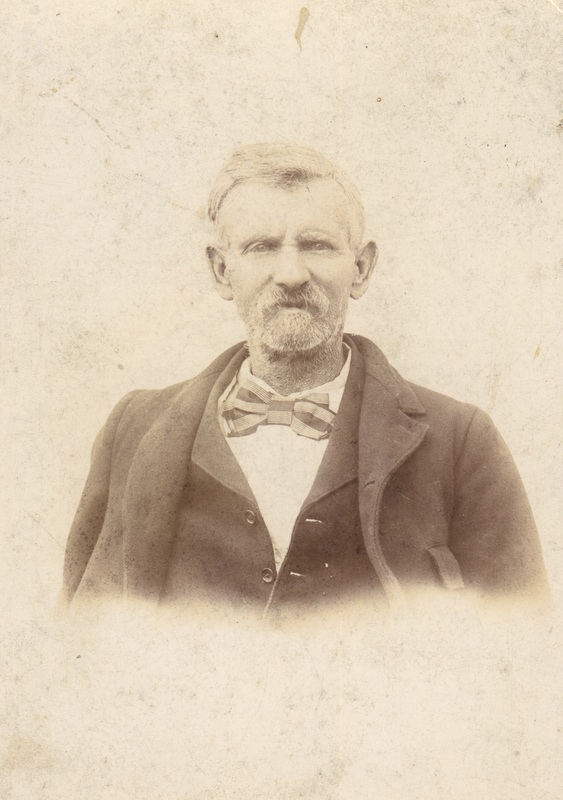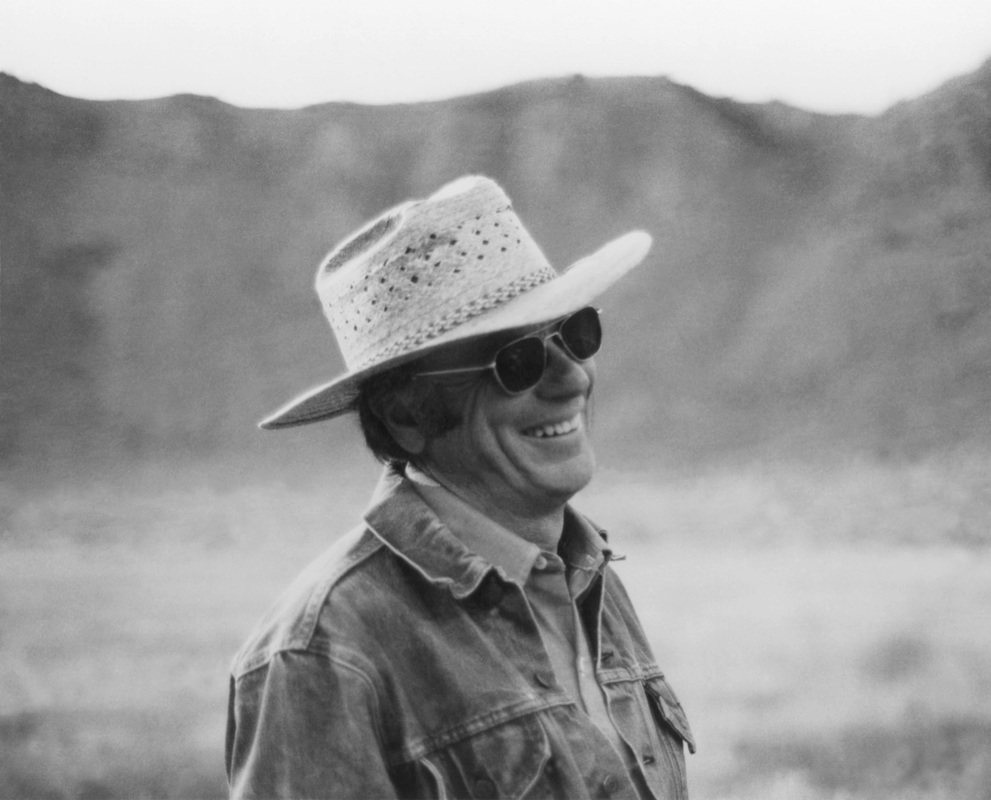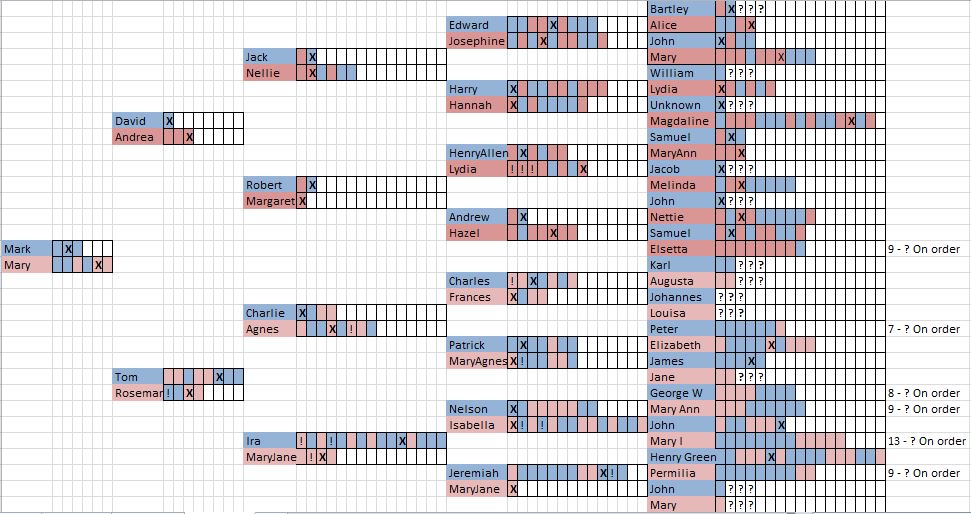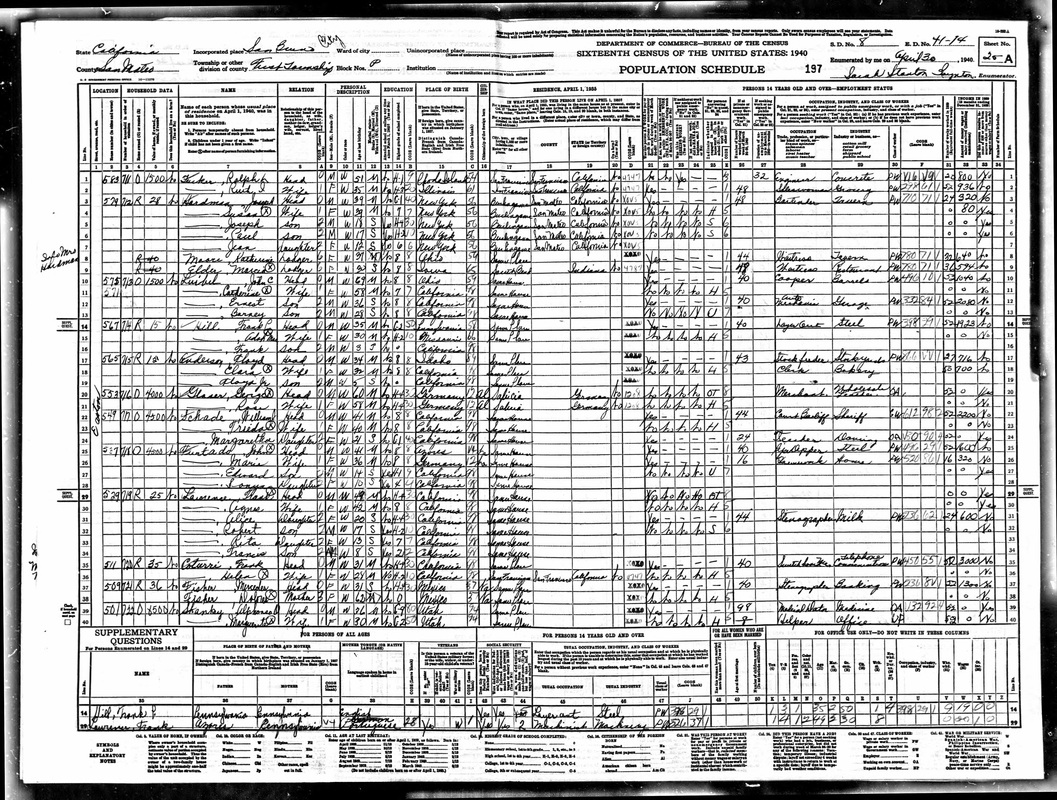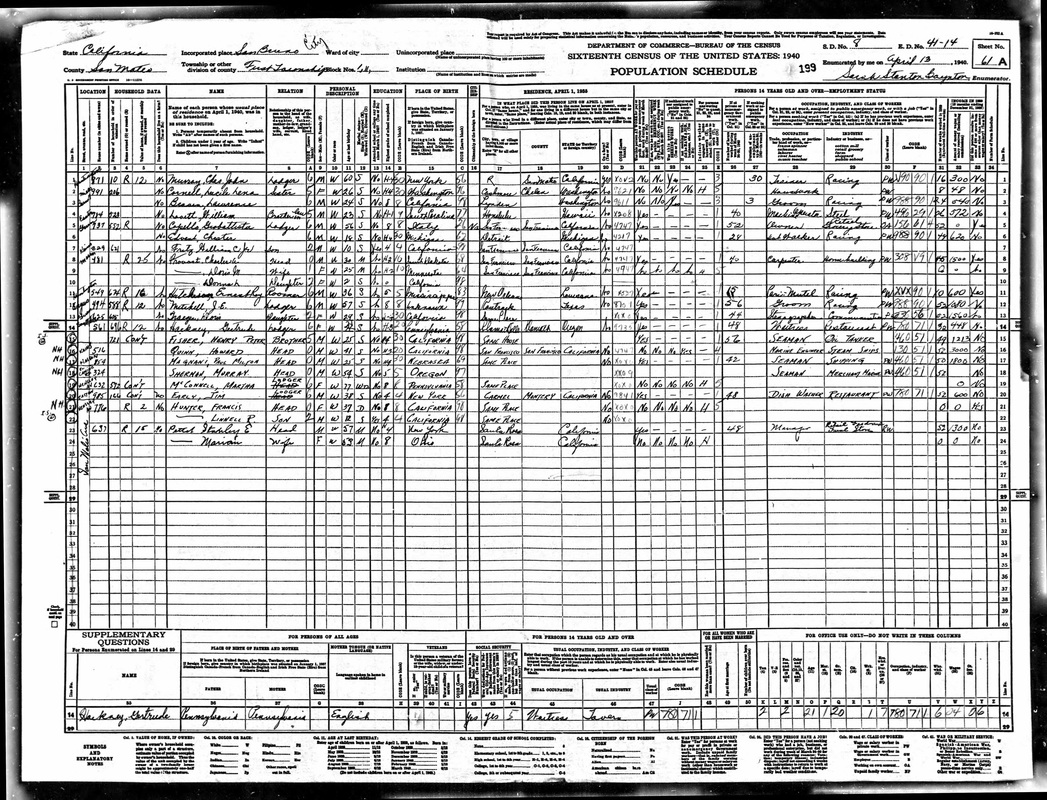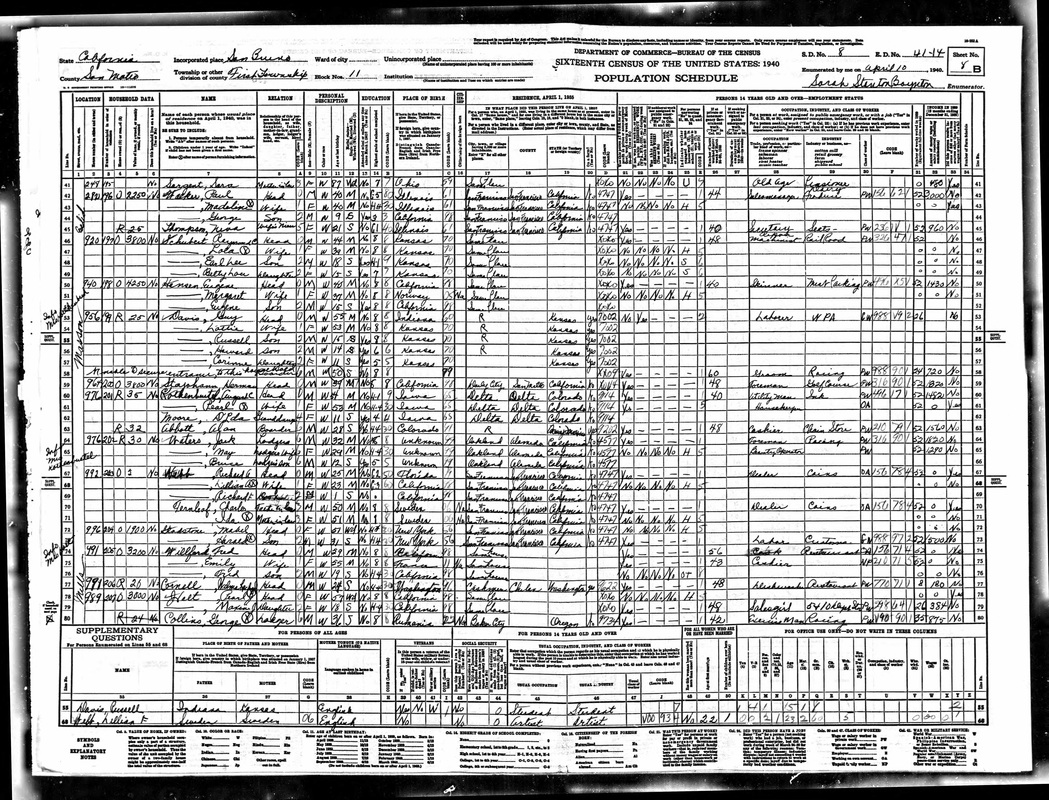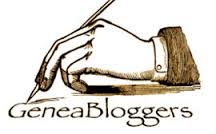|
Tuesday’s tip – connect with a cousin. You never know what you’re going to find.
Before I left Seattle, I reached out to a few of Mark’s relatives, just to see if I could spend a little time with them. And did I score! I contacted Carol and she invited me to her home tonight. Her husband, Al, was Mark’s dad’s cousin. She invited Al’s sister, Lois to come too. While I was there Carol shared with me a whole file of genealogy Mark’s Grandma Nellie had prepared. Um… why have I never seen this before? I’ve got much work ahead of me to sort and catalog all the details, but I’ve already found the answer to one whose-that-guy-in-the-picture mystery. We have scans of many of Nellie’s old pictures. We recognize many of the people in them, and can infer others, but one lone photo has had us stumped. Until tonight, when I saw the two pages, written in Nellie’s perfect penmanship, which began “All I can tell you of Mom’s (Hanna White) grandparents…” Nellie relates many stories of William Spurling and his wife, Hannah Merritt, and at the end of the second page she says “I have a small snap shot of William Spurling.” That snap shot is my scan. And now I know.. Mystery solved. Get out there and bag a live one. You just might solve your own mystery.
0 Comments
I’m off to Ohio to speak at the Ohio Genealogical Society conference and I’m excited to get to sneak in a few days of genealogy research before the conference starts. I’ll be going to some libraries and archives and meeting with some of Mark’s distant relatives on his Dad’s side as well.
Mark, Emmeline and I were having dinner last night and talking about my upcoming trip and Mark asked Emmeline if she remembered her Grandpa David. Emm was only nine when he died, and he’d lived in Arizona so she didn’t have a ton of contact with him. “A little,” she said. “I remember he used to give us presents and he always put a whole bunch of tape on them.” Mark laughed. “Yep. That’s him, alright!” David was an astrogeologist with the United States Geological Survey. His specialty was cratering mechanics, and while he studied some naturally occurring craters caused by meteors, he also studied some man-made craters. For instance he knew the size and shape of craters that various types and sizes of bombs or explosives could create. You don’t want to let that kind of information fall into the wrong hands. With his high-level government security clearance came some high level security measures. Mark talked about David’s main office and then his office next door for the super super secret stuff which Mark dubbed “the vault.” When David passed away, Mark and his brothers were barred by the government from entering his house for a period of time while officials combed the premises to gather up whatever potentially top-secret material he might have been working on. And as Emmeline correctly recalled, David’s thoroughness with regard to security was not limited to his professional life. Three-hundred or so feet of clear packing tape wrapped around the box would ensure that no Russian spy would ever know what was in his granddaughter’s birthday gift! Yep, gotta keep that top secret info out of the wrong hands. Families come in all different shapes and sizes. Some are small with only one child, and some have 15. Some are mostly boys, some mostly girls and some more even mix of genders. How do those kinds of differences impact a couple when they marry?
I’ve seen firsthand what some of these differences look like. I’m one of six children and my father is one of eight. Our holiday celebrations were big to-do’s with lots of relatives, and tables set up in dining rooms, kitchens and family rooms to seat all the cousins, aunts and uncles who gathered to celebrate. How proud you were when you finally “graduated” to the grown-ups table. But my husband had a much different experience – he was one of three boys, his father was an only child, and his mom had two sisters who lived half-way across the country. For me, a big table with lots of people around it seems a requirement to a proper holiday celebration, and it’s taken some time for Mark to understand why I might be a little blue when it’s just us and the kids for Easter (and worse now, when it’s only the two of us as the kids grow up and establish traditions that involve their spouse or partner and what a holiday means to them!) But it’s not just holidays. Birth order and family size shape our personalities. Parents like to think they make all the mistakes on the first born, but that first born also gets a lot of attention and expectations heaped upon him. Imagine the experience of a baby boy born into a house with four or five older sisters who may dote on this new little doll and spoil him rotten – the woman who marries that little prince better be prepared for a man who expects he will continue to be treated like royalty. And in how many families is the youngest daughter expected to put her life on hold and tend to her aging parents – my great-aunt Brownie was just such a daughter, and didn’t marry until she was 40, after her parents had passed away (and then she managed to have three babies in 31 months!) To help me look at this phenomenon of how family size and birth order might play into peoples’ lives, I’ve created a chart. On this chart, I’ve captured both my husband’s and my ancestors, just to see how different we are in some generations and perhaps how similar in others. Genealogists out there might recognize it’s a bit of a different presentation than your standard generation chart because I wanted to show husbands and wives right next to each other to try to make some sense of the impact their childhood experience might play in their union. It’s not necessarily a straight-up “genetic” chart because in those instances where one parent died and the remaining parent remarried, I tried to include the half-siblings wherever they fell into the family. For the nitty-gritty of the chart, I’ve used those standard (aka sexist) colors of pink for girls and blue for boys. I put an X for ourselves and our direct ancestors’ places in their families. And because I recognize that the loss of a child impacts the siblings and parents in powerful ways, I used an exclamation mark “!” to designate siblings lost sometime in childhood. With my own research, I could come up with the family size and structure from my generation up to the great-grandparent level fairly easily, but ran into some trouble beyond that. For instance, with some of my Irish and German immigrant ancestors I don’t know much about their family of origin or their place in it. I’ve got a lot of question marks… A shout-out to genealogist, J Paul Hawthorne, who started the colored chart phenomenon. It really has captured my imagination as to how a graphical representation of data can make it come alive. If you want to do your own chart, I’ve created a blank chart, all ready for you to fill in with names and pink and blue boxes. You can see it on my website at http://www.mkrgenealogy.com/links.html Fill in your family and let me know if you find any insight into your ancestors' couplehood! 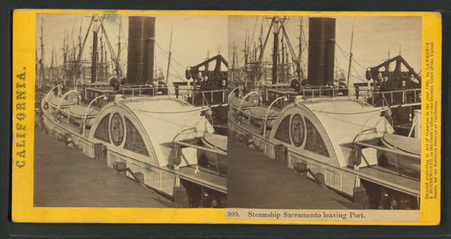 Steamship Sacramento Leaving Port, by Thomas Houseworth & Co. -- Publisher [Public domain], via Wikimedia Commons Steamship Sacramento Leaving Port, by Thomas Houseworth & Co. -- Publisher [Public domain], via Wikimedia Commons I’m a knitter and I love one scene written by Annie Proulx. It cracks me up every time. "I can tell you about the time buddy was ripping along down the Trans-Canada knitting about as fast as the truck was going when this Mountie spies him. Starts to chase after him, doing a hundred and forty km per. Finally gets alongside, signs the transport feller to stop, but he's so deep in his knitting he never notices... Mountie flashes his light, finally has to shout out the window, 'Pull over! Pull over! So the great transport knitter looks at the Mountie, shakes his head a bit and says, "Why no sir, 'tis a cardigan.' "[1] The book is of course, The Shipping News. Reading the shipping news in the newspaper might not be quite as giggle-inducing, but could provide some wonderful details to include when writing your family story. Do you have ancestors who sailed from Europe to the New World or perhaps from Boston or New York, bound for California? If you’ve got a date and a ship’s name for such an adventure you may find some specifics about the voyage. I knew from my great-grandmothers application to Native Daughters of the Golden West, a California lineage society, that she arrived in San Francisco in May 1867 aboard the vessels Ocean Queen and Sacramento. With the month and year and ship names, I scoured the newspaper looking for either of those ships arriving in San Francisco, and on page 3 of the Daily Alta California of May 25, 1867 in the Shipping Intelligence column, “Arrived, May 24, Stmr Sacramento, Cavarly, 14 days 2 hrs from Panama.” [2] But wait, there’s more! (Oh, yes… always read the entire paper!) On page 1 I found “From Panama: Arrival of the Steamer ‘Sacramento,’” a 1000+ word article providing details of the Sacramento’s latest round-trip San Francisco-Panama voyage. She “left Panama May 10th at 3:56 p.m. with 590 passengers” and assorted freight, mail and baggage. She stopped at Acapulco, Manzanillo, and Cape St. Lucas on her northward journey, and “experienced fine pleasant weather the entire voyage. Passengers and crew all well.” Among those 590 passengers were “Miss M. Hearn and bro,”[3] my great-grandmother, Mary Agnes Ahern and her brother, Henry. Further details from the account told me that the Sacramento was carrying freight from the Ocean Queen from New York, and in a “Passengers Sailed” column in the New York Times on page 8 of the May 2nd issue, I found two exciting names – “Miss Mary Hearn and brother.”[4] OK 1 ½ exciting names – poor Henry! memorialized in two newspapers as “brother.” I was lucky that my great-grandmother traveled first class on these ships so her name was listed in the newspaper, but even if she’d been in the nameless hundreds in steerage,, the shipping news columns could tell me much about her journey. Read The Shipping News (book) and the shipping news in the paper. Search for “Passengers Sailed,” “Arrivals,” “Marine Intelligence,” and more. It’ll help to fill out more stories of your ancestors’ lives. [1] The Shipping News: A Novel, Annie Proulx, Simon and Schuster, 2008 [2] Daily Alta California, Volume 19, Number 6280, 25 May 1867, page 3, accessed 19 April 2016 from the California Digital Newspaper [3] Daily Alta California, Volume 19, Number 6280, 25 May 1867, page 1, accessed 19 April 2016 from the California Digital Newspaper [4] “Passengers Sailed” New York Times 02 May 1867, page 9, accessed 19 April 2016 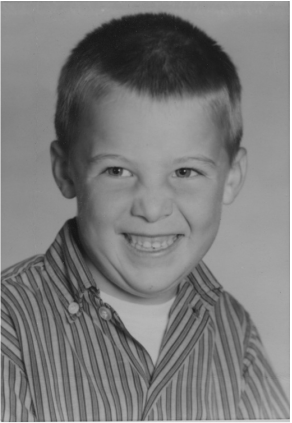 My brother, Mark, passed away 21 years ago, tomorrow, just a few months shy of his 40th birthday. He was artistic and smart, filled with curiosity and imagination. I suspect if he’d been born in 2005 instead of 1955 he would have been diagnosed with Attention Deficit Hyperactivity Disorder, but ADHD wasn’t something my parents knew about, and the manifestations of Mark’s curiosity (I want to know how a radio works so I’ll take it apart!) were not celebrated, but were instead punished. I think my parents had good intentions when it came to raising their children, but sometimes the upbringing and temperament of a parent may put them at odds with a child at the opposite end of a behavioral spectrum. I’m afraid this was the case with Mark and Dad. In his early adolescence, Mark was a faithful altar boy and an avid boy scout. I don’t have any concrete verification, but given his unusual sexual behaviors and his alcohol addiction, I would not be the least bit surprised to find out that a priest or scout leader had sexually abused him. His sexual identity and substance abuse were a constant source of conflict for Mark for the remainder of his life. After more than two decades living as a gay man, Mark married a woman. I don’t think I ever understood it. It did not appear he was particularly happy in the marriage. I don’t know if it was the fact that he and his wife, her two teenage daughters, the daughters’ babies, and at some points the daughters’ boyfriends all lived together in a 2-bedroom/1-bath apartment, or if in marrying a woman he was trying to be something he wasn’t. Whatever the reasons, his life did not seem to bring him much joy. He’d also had some serious medical issues concerning his heart. I don’t know the full nature of them, but he’d had a heart valve replacement in 1993. He should have quit drinking and taken better care of himself. With the heart issues, I’m pretty sure he should have been under a doctor’s regular care, and probably on some meds, but none of that was part of his routine. Mark called me on Good Friday, 1995. One of the first things he asked was, “Do you think Mom knew she was going to die?” (Our mother had a hysterectomy due to uterine cancer in 1970. The doctors said they thought they’d gotten it all, so there was no need for chemo or radiation. They were wrong, and five years later she wound up with cancer throughout her body. She underwent chemo for a couple of years with a local physician in San Rafael, but that stopped, and my parents told us that Dr. Carrigg had done everything he could with the drugs he had access to, and he was sending Mom to UC San Francisco for some different kind of treatment. A few weeks later, before any trip to UCSF, she died. Was there really any further treatment to be had? Or was that just a story the doctor told my parents, or my parents told their children?) So when Mark asked if I thought Mom knew she was going to die, I said yeah, I thought so. A priest had come to our house the week before she died. We weren’t the kind of family that had priests come to the house. Some families are, but we weren’t. So yeah, I think Mom must have known. It was early afternoon, but Mark had been drinking and continued to do so during our phone conversation. As I spoke with him, I was cleaning house, doing the dishes, trying to get ready for my sister and her family to come for the Easter weekend. Though it lasted about an hour, I don’t remember much of that conversation, other than the initial question about Mom, and the end of the call. My kids, aged 5 and 2, had pretty much been left to their own devices while I was talking to Mark, but finally I could ignore them no longer. “Mark, I’ve gotta go. I’ll talk to you later.” He replied, “Yeah, maybe.” Those were the last words Mark said to me. My sister arrived a few hours later, steaming. It seems after Mark hung up with me, he called her. Like I said, he was drinking while he was on the phone with me, and then with her, and one of his more “choice” comments to her was “If you hear of somebody jumping off the Golden Gate Bridge this weekend you’ll know it was me.” Four days later, the Tuesday after Easter, my dad called with the news that Mark was dead. No, it wasn’t the bridge. He’d died in his apartment. But I couldn’t bring myself to ask how. We buried him a few days later, in the plot right next to my Grandma and Grandpa Brown. It was comforting to know that he was right next to Grandma. She loved Mark very much. She loved all her grandchildren. Mark was my next older brother, five years older than I. Growing up, I really didn’t ever imagine Mark would make it to his 30th birthday, but he made it almost to 40. For many years, I didn’t know how Mark died. I couldn’t ask. I was too scared to hear the answer. One time I even went to the vital records office in Marin County. I walked into the office and stood there. I had three death certificates I wanted – my great-grandparents, Mary and Tom Bradley’s, and Mark’s. I didn’t have $45 to spend on the three records, and I couldn’t decide which one I wanted, so I turned and walked out with none. In 2008, a few months before my father died, I was finally ready to find out how Mark died. Even then, I couldn’t bring myself to ask Dad, still afraid of what the answer might be. But I wrote for the coroner’s report. The medical cause of death was “cardiac dysrhythmia due to marked cardiomegaly from left ventricular hypertrophy.” The coroner’s verdict was that “Mark Damian Kircher died due to or as a consequence of natural causes.” The complete drug screen detected only maprotiline, an antidepressant, in his system. No blood ethyl alcohol detected.[1] Natural causes. I was relieved to finally know. Thinking back to Mark’s question from Good Friday 1995 about whether Mom knew she was going to die… I think Mark was looking for the answer about himself. He must have felt signs from his failing heart and wanted to confirm those signs meant his own end was near. I’m sorry we lost Mark. I wish my children could have known him. But I am glad that he is finally at peace. Love you, Mark. [1] Office of the Coroner, County of Marin, Coroner’s Report in the Matter of the death of Mark D. Kircher, Case No. 95081, dated April 18, 1995 Sometimes it is tempting to put in a birth year when searching for someone in a census. After all, if you know he was born about 1919, why wouldn’t you want to narrow the search? Well, including that might narrow your search results down to a big fat nothing! Here is an example from the 1920 census for the household of Robert Powers. Robert is listed along with his wife, Annie, and daughter, Caroline, on Sheet 2A with additional children Rose, Robert, Edward and Norma shown on Sheet 2B. Also living in the household is lodger, George Hartman. George is actually the illegitimate child of Caroline Powers, and perhaps the sensitive nature of his birth is why he is listed as a lodger and not a grandson. But look at George’s age. At first glance it looks like a “big” 7 followed by a 2. Many indexers have transcribed this as 72. But a more careful reading, combined with examination of the other ages written by enumerator, Mrs. M. K. Henderson, shows that for all the two-digit ages, both digits are written the same size. Mrs. Henderson does not tend to write one digit larger than another. Also, take a look at the fractional ages of the other young children. While some enumerators use a slash (/) between the numerator and denominator, Mrs. Henderson uses a dash (-). The 7 above the dash has melded into the 1 (of the number 12) below the dash, making it look like a large 7 (written with a mark across the 7) followed by a small 2. However, based on other numbers written by Mrs. Henderson, she does not tend to make her 7s with a mark across them, nor does she use an oversized 10s digit, as shown in the age of Fanny Gizer, aged 79. Mrs. Henderson has correctly listed George Hartman as age 7/12, and it is the transcription that is wrong.
There are three take-aways from this exercise: 1) Be careful when entering a birth year to search for someone in the census that you don’t narrow your search parameters so much that you miss them all together. 2) Study the enumerator's penmanship to see how letters and numbers were written. 3) When you find an error in the transcription, notify the image provider. I have done this with both Ancestry.com and FamilySearch to make it easy for the next researcher looking for George to find him. 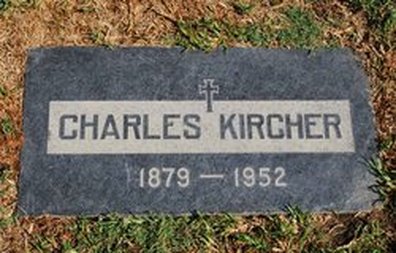 This weekend Mark and I took a road trip to Portland. Saturday night we attended William Shakespeare’s Julius Caesar (which was actually Julia Caesar) at the University of Portland. Melinda, our youngest, was assistant stage manager as well as part of the costume crew. We stayed with my college friend, Karrie, and her husband, Geoff. This morning they took us out to see Multnomah Falls, and along the way they pointed out Vista House at Crown Point, a rest station and view point about 24 miles east of Portland, on a bluff high above the Columbia River. When it was constructed in the mid-1910s, this would have made for a nice Sunday drive. The trip got me thinking about Sunday drives my parents took me on in my childhood and about my grandparents, Charlie and Agnes. They used to enjoy a Sunday drive – often on a Wednesday. Charlie was an engineer on the ferryboat, Eureka, and generally had a day off mid-week. They might pack a picnic lunch and find a scenic spot to lay out a blanket and enjoy some tasty treats. As I understand from my father, often as not one of these scenic spots might very well be a cemetery. (Seems I come by my fascination with graveyards honestly.) As they nibbled on a sandwich or a bite of potato salad, they’d survey the names and dates on the stones, and by the time lunch was over they’d have recreated the whole town in their imaginations – who was married to who, who were the movers and shakers, why that young man died at only 17, who would have been the wise old founders of the place – all based on the names and dates etched upon the flat slabs and majestic plinths marking final resting places. I suspect it was a bit more imagination than actual research, but I sure wish Grandma Kircher could somehow communicate her discoveries from those cemetery jaunts. Ironically, when Grandpa died in 1952 and Grandma ordered the stone to mark his grave, she left the most meager of informational crumbs on the marker for future picnickers (or genealogist-granddaughters!) There were only two words, Charles Kircher, and a cross. No middle name. No dates. I imagine Grandma expected that when the time came to place her marker, it, too, would say nothing more than Agnes Kircher. I don’t know… perhaps she even had her simple black granite piece made when they made Grandpa's. But thank goodness for my Aunt Mary. Before the stone was placed on her mother’s grave, she made sure that both markers showed the years of birth and death for her dear parents. Not much detail to make up a story about, but it’s at least a start – a morsel of information for an intrepid picnicker to find on a Sunday drive. I was searching for someone in the 1940 census in San Bruno, California and I noticed something odd. Partway down the page, the enumerator’s handwriting changed from cursive to block printing. It certainly got my attention and I’m glad it did. I learned a new trick. When you’re looking at a census for an enumeration district (ED), and you find the family you’re looking for, do you skip ahead to the last pages of the ED to see if there were other people in the same household that were listed on another page of the enumeration. Here’s an example from the 1940 census for San Bruno, San Mateo, California, ED 41-14, sheet 25A. On lines 37 and 38, residing at 509 Easton Street are 31-year-old Mercedes Fisher and her 62-year-old mother, Dolores Fisher. It was Dolores who provided the information. According to the number in column 3, this was the 721st household visited by the enumerator, Sarah Stanton Boynton. Since Ms. Boynton then moved on to enumerate household 722 at 501 Easton Street, you might have thought she’d listed everyone living at #509. Whoa. Not so fast there! Take a look at sheet 61A for ED 41-14.[1] There on line 15 is listed Fisher, Henry Peter, brother. No, he is not the brother to Hackney who appears just above him on line 14. He is the brother of Mercedes Fisher from Sheet 25A. How do I know this? Because in column 3 of Henry Fisher’s line, it says “721 Cont” meaning the continuation of household 721. Henry Fisher’s isn’t the only household continued on Sheet 61A. If you look at Line 2 on this page, you’ll see Lucille Lena Cornell, living at 991 Mills, visitation number 206. Go back to Sheet 8B, line 77, and you’ll find Lucille’s sister, Wilma Rachel Cornell, listed as the head of household. If you looked only at Sheet 8B you’d think Wilma lived alone and never know about Lucille. I can’t speak for every census, but I know this is not a problem peculiar to the 1940 census. I’ve seen similar “addendums” to households in the 296th ED in San Francisco in 1900.[2] Word to the wise – always remember to check the last few pages of an enumeration district to see if any additional household members are hiding there.
This is just one of the 20+ tips in my Censation Census Strategies talk. I’ll be presenting it at the 2016 Northwest Genealogy Conference in Arlington, Washington on August 18th. I hope to see you there. [1] Ancestry.com shows 55 images in ED 41-14. The images are in sets of two, an A and a B sheet, Sheets 1A-15B are images 1-30 in the set. Sheet 15B is appears again as image 31. Images 32-53 are labeled as Sheets 16A-26B. The final 2 images in the set, 54 and 55 are Sheet 61A and 61B. [2] 1910 US Federal Census for California, San Francisco, San Francisco, ED 0296, Sheet 8, lines 29-32, Pope family, (Ancestry.com image 15 of 21) and 1910 US Federal Census for California, San Francisco, San Francisco, ED 0296, Sheet 11, lines 29, Sydney Pope (Ancestry.com image 21 of 21) 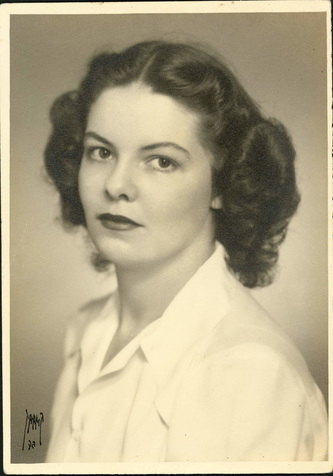 This piece was originally posted in LifeStory Magazine in May 2013 under the title "All About the Pretty.". I present it here on my blog on this day as a memorial to my mother who lost her long battle with cancer 39 years ago today My mother was all about the pretty. But not in a bad way. It was all about trying to do your best, look your best and be your best self. Mom kept a beautiful home. She had an eye for furnishing and decorating, and knew a bargain when she saw it - whatever she might have been doing at the time. In 1950 she’d been married less than a year and found herself being wheeled across the lobby of Children’s Hospital in San Francisco on her way up to the maternity ward to have a baby. When she was finally settled in, she asked the nurse what was all that mess in the lobby. “Oh, they’re remodeling,” the nurse replied. Mom wanted to know what they were going to do with the furniture. The nurse checked and found out it was for sale. “Tom,” my mother addressed my father, “go downstairs and get me two of those wing chairs.” My dad bought them for ten bucks each, and the happy young family left the hospital with two chairs and a bouncing baby boy. Mom was a wonderful hostess and cook. Whatever she cooked was delicious and her plates were a work of art. She loved her blue and white dishes, and arranged the food “just so” on them. I still make my Thanksgiving mashed potatoes as she did, with a dash of Tabasco sauce instead of ground black pepper – nothing to spoil the fluffy whiteness! I have a set of the same dishes we grew up with, Denmark by Franciscan. When I fix one of her special recipes, Elinor’s Dish, named for her best friend, seeing it on these special plates brings me right back home. She taught me to sew when I was 12, in sixth grade. We made a yellow “peasant dress,” all the rage in 1972. I can still see the light stream into the windows in her bedroom where the sewing machine was set up and hear the rustle of the Simplicity tissue pattern pieces. Thirty years later when I was teaching my own daughter, Emmeline, to sew, the experience was a gift from a grandmother she never knew. Christmas was a very special time for Mom to make things sparkle. We had the big tree, of course, but she had a special little tree. It sat on a table and she decorated it with tiny white lights and gold angels. It would twinkle so! Mom loved that tree and recreated it year after year. Other holidays, too, were given their proper due – Easter would be the holiday for matching dresses for my sisters and me. And every October Mom managed to design and execute a new Halloween costume for me. The most elaborate one was probably 1968 when I joined in the costume parade at St. Raphael’s school dressed as Sister Bertrille, the Flying Nun. I think my parents stayed up all night the night before creating the cornette hat, Dad stabbing himself with the coat hanger trying to prop out the wings and Mom bandaging his hand and trying to remove the bloody evidence from the starched white costume. My younger daughter, Melinda, is the one who inherited Mom’s holiday panache. She asks when we’ll decorate, and then reminds, and eventually just goes up in the attic to retrieve the boxes of decorations, depositing them in the middle of the living room or on the dining room table so we have no choice but to decorate NOW! But I know her grandmother’s legacy of dressing up the house for the holidays shines through her as much as the brown eyes and high cheekbones she also inherited from my mother. I lost Mom to cancer when I was only 17, long before I had a home or children of my own. But the legacy she left fills every day of my life and the things that are pretty in it have been made pretty because of her. Oh, and those wing chairs? My husband and I are sitting in them right now. |
AuthorMary Kircher Roddy is a genealogist, writer and lecturer, always looking for the story. Her blog is a combination of the stories she has found and the tools she used to find them. Archives
April 2021
Categories
All
|
